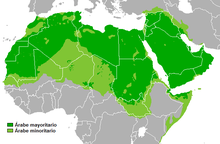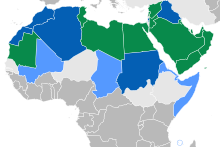Arabe
| Arabic |
العَرَبِيَّة / عَرَبِيّ
ʻarabī / al-ʻarabiyyah
|

al-ʿArabiyyah in written Arabic ( Naskh script)
|
| Pronunciation |
/ˈʕarabiː/, /ʔalʕaraˈbijja/
|
| Native to |
Countries of the Arab League, minorities in neighboring countries and some parts of Asia, Africa, Europe |
|
Native speakers
|
290 million - 420 million (2017) |
|
|
|
|
Early form
|
|
|
Standard forms
|
|
| Dialects |
|
|
|
Arabic alphabet
Arabic Braille
Syriac alphabet (Garshuni)
Hebrew alphabet (Judeo-Arabic languages)
Greek alphabet (Cypriot Maronite Arabic)
Latin script (Romanized Arabic alphabet, Maltese alphabet) (Maltese, Lebanese Arabic, Hassaniya Arabic, Moroccan Arabic, Libyan Arabic, Tunisian Arabic) |
|
|
Signed Arabic (national forms) |
| Official status |
|
Official language in
|
Modern Standard Arabic is an official language of 28 states, the third most after English and French
|
|
Recognised minority
language in
|
|
| Regulated by |
|
| Language codes |
| ISO 639-1 |
ar |
| ISO 639-2 |
ara |
| ISO 639-3 |
Individual codes:
|
| Glottolog |
arab1395 |
| Linguasphere |
12-AAC |

Dispersion of native Arabic speakers as the majority (green) or minority (chartreuse) population
|

Use of Arabic as the national language (green), as an official language (dark blue), and as a regional/minority language (light blue)
|
|
This article contains IPA phonetic symbols. Without proper rendering support, you may see question marks, boxes, or other symbols instead of Unicode characters. For an introductory guide on IPA symbols, see Help:IPA. |
Arabic (Arabic: العَرَبِيَّة, al-ʻarabiyyah [ʔalʕaraˈbijːah] or Arabic: عَرَبِيّ ʻarabī [ˈʕarabiː] or [ʕaraˈbijː]) is a Central Semitic language complex that first emerged in Iron Age northwestern Arabia and is now the lingua franca of the Arab world. It is named after the Arabs, a term initially used to describe peoples living from Mesopotamia in the east to the Anti-Lebanon mountains in the west, in northwestern Arabia, and in the Sinai peninsula.
The modern written language (Modern Standard Arabic) is derived from Classical Arabic. It is widely taught in schools and universities, and is used to varying degrees in workplaces, government, and the media. The two formal varieties are grouped together as Literary Arabic (fuṣḥā), which is the official language of 26 states and the liturgical language of Islam. Modern Standard Arabic largely follows the grammatical standards of Classical Arabic and uses much of the same vocabulary. However, it has discarded some grammatical constructions and vocabulary that no longer have any counterpart in the spoken varieties, and has adopted certain new constructions and vocabulary from the spoken varieties. Much of the new vocabulary is used to denote concepts that have arisen in the post-classical era, especially in modern times.
...
Wikipedia



